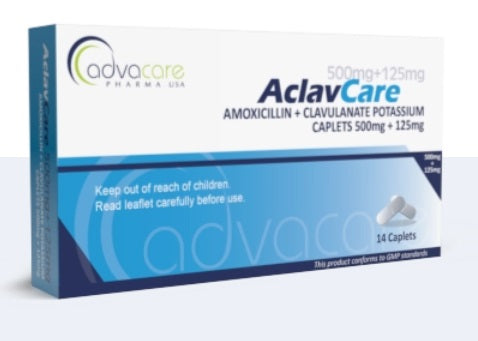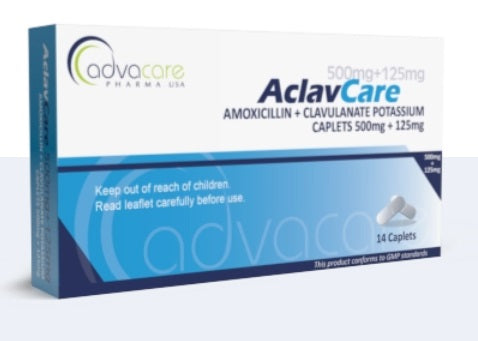Amoxicillin + Clavulanic Acid 325mg – Trusted Antibiotic for Effective Infection Treatment
Amoxicillin + Clavulanic Acid 325mg is a highly effective antibiotic combination used to treat a wide range of bacterial infections. The combination of Amoxicillin, a penicillin-type antibiotic, and Clavulanic Acid, a beta-lactamase inhibitor, helps prevent bacteria from becoming resistant to the medication. This makes it a powerful option for treating both common and complicated infections.
Whether you’re dealing with respiratory infections, urinary tract infections (UTIs), skin infections, or more, Amoxicillin + Clavulanic Acid 325mg offers reliable and rapid relief. Its dual action fights bacteria at their core, ensuring a quicker recovery and preventing the spread of the infection.
Key Benefits:
- Broad-Spectrum Antibiotic: Effective against a wide variety of bacterial infections, including ear infections, pneumonia, bronchitis, sinusitis, and more.
- Enhanced Effectiveness: The addition of Clavulanic Acid enhances Amoxicillin’s ability to fight resistant bacteria, increasing its overall effectiveness.
- Fast Acting: Provides quick relief from infection symptoms, helping you recover faster.
- Trusted Quality: Produced with the highest standards to ensure safe and effective use.
Why Choose Amoxicillin + Clavulanic Acid 325mg from Allvigor.store?
- Trusted Online Pharmacy: At Allvigor.store, we provide only authentic and high-quality medications. Our Amoxicillin + Clavulanic Acid 325mg is sourced from reputable manufacturers to ensure you receive a product you can trust.
- Secure Shopping Experience: Your privacy and security are our top priority. Shop with confidence knowing your personal and payment details are always protected.
- Fast & Reliable Shipping: We offer quick, reliable delivery, so you get your medication on time and in perfect condition.
- Excellent Customer Support: Our team is always ready to assist you with any questions or concerns. Feel free to reach out if you need help with your order or have inquiries about the medication.
How to Use:
Follow your doctor’s instructions for the proper dosage and usage of Amoxicillin + Clavulanic Acid 325mg. Typically, it is taken orally with or without food. Be sure to complete the full course of antibiotics even if you start feeling better to prevent bacterial resistance.
Buy Amoxicillin + Clavulanic Acid 325mg Today!
Don’t wait to treat your infection. Order your Amoxicillin + Clavulanic Acid 325mg today from Allvigor.store, where we prioritize your health and convenience. Trust us for reliable medications, fast delivery, and a secure shopping experience.
Buy now at Allvigor.store – your trusted source for medications.
Penicillin is a widely known antibiotic used to treat a variety of bacterial infections. It belongs to the beta-lactam class of antibiotics and is effective against many types of gram-positive and some gram-negative bacteria. Penicillin works by inhibiting the synthesis of bacterial cell walls, ultimately leading to the destruction of the bacteria.
Common Uses of Penicillin
Penicillin is prescribed for the treatment of various bacterial infections, including:
- Strep throat
- Pneumonia
- Scarlet fever
- Skin infections
- Ear infections
- Sinusitis
- Dental infections
- Syphilis and other sexually transmitted infections
- Rheumatic fever prevention
The specific type of penicillin and its dosage depend on the nature and severity of the infection.
How Penicillin Works
Penicillin interferes with the formation of the bacterial cell wall by binding to proteins involved in the process. This action weakens the wall, causing the bacteria to burst and die, effectively clearing the infection.
Dosage and Administration
Penicillin is available in various forms, including tablets, capsules, liquid suspensions, and injectables. The dosage and frequency of administration depend on the type of infection being treated, patient age, and overall health. Tablets are typically taken orally, with or without food, as directed by a doctor. It’s important to complete the full course of treatment, even if symptoms improve before finishing the medication, to prevent antibiotic resistance and ensure the infection is fully eradicated.
Important Precautions
Before starting penicillin, inform your doctor if you:
- Are allergic to penicillin, cephalosporins, or any other medications.
- Have a history of asthma, kidney disease, or any significant medical condition.
- Are pregnant, planning to become pregnant, or breastfeeding. Penicillin is generally considered safe during pregnancy and breastfeeding, but medical advice should be sought.
Certain medications, including some over-the-counter drugs and supplements, can interact with penicillin. Be sure to disclose all medications you are taking to your doctor or pharmacist.
Potential Side Effects
While penicillin is typically well-tolerated, some individuals may experience side effects, including:
- Mild nausea or vomiting
- Diarrhea
- Headache
- Oral thrush or vaginal yeast infections
More serious side effects, which require immediate medical attention, may include:
- Severe allergic reactions (hives, swelling of the face, throat, or tongue, difficulty breathing)
- Severe diarrhea that may indicate a more serious intestinal condition (Clostridioides difficile infection)
- Rash or unusual skin reactions
Allergic Reactions
Penicillin allergy is one of the most common drug allergies. Symptoms may range from mild skin rashes to severe anaphylactic reactions. If you have a known penicillin allergy, alternative antibiotics will need to be considered. If any signs of an allergic reaction occur, such as itching, rash, swelling, or difficulty breathing, seek emergency medical attention immediately.
Storage and Handling
Penicillin tablets should be stored at room temperature, away from excessive heat, moisture, and light. Keep the medication out of reach of children and pets. Any unused or expired medication should be disposed of properly, and pharmacists can guide you on safe disposal practices.
Final Notes
Penicillin has saved countless lives since its discovery and remains an essential treatment for bacterial infections. However, misuse or overuse can contribute to antibiotic resistance. Always follow your doctor’s instructions, avoid self-prescribing, and never share antibiotics with others.




